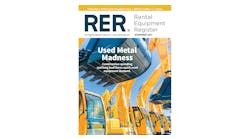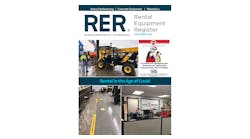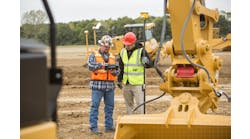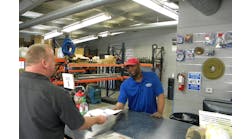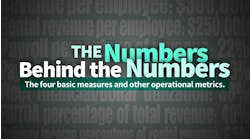THE PARTICIPANTS:
John Bartz, director, product assurance & regulations, Volvo Construction Equipment North America;
Curtis Goettel, marketing manager, Case Construction Equipment;
Joe Mastanduno, product marketing manager, John Deere Construction and Forestry;
Doug Laudick, manager of product planning, John Deere Power Systems
Allister Dennis, product marketing manager, Perkins Engines
Regarding Tier 4, what do rental companies need to know essentially about what to do to keep current with regulations? What are the timeline issues rental companies need to be aware of?
Bartz: As far as timelines, Tier 4i is introduced by power range: 175 hp to 750 hp started in January of 2011; 75 hp to 175 hp starts in January of 2012; and 25 hp to 75 hp started in 2008. Your machine supplier will provide new equipment compliant with these regulations. Keep in mind that the EPA allows manufacturers some provisions to continue to supply Tier-3 equipment in Tier-4 years so not all machines change over at the same time. With the introduction of Tier 4i, ultra low sulfur diesel is required along with low ash oils. Using anything else will damage components or shorten service intervals.
Goettel: Rental companies should understand the basics of the two technologies that are being implemented to meet Tier-4 Interim requirements: selective catalytic reduction (SCR) and cooled exhaust gas recirculation (CEGR).
In an SCR system, the engine is tuned for maximum efficiency. The higher combustion temperatures reduce PM levels but increase NOx levels. SCR is an after-treatment-only system that creates a chemical reaction by adding diesel exhaust fluid (DEF). This transforms the NOx into nitrogen and water, which occur naturally in the atmosphere. No particulate filter is required because PM levels are low due to the higher combustion temperatures.
SCR allows for a quiet system that's separate from the main engine function and does not compromise horsepower or torque. It does not interfere with engine performance, and actually improves performance, because it allows the engine to breathe more freely. The SCR after-treatment system requires the addition of diesel exhaust fluid (DEF). The after-treatment system is composed of a supply module, a DEF tank, a dosing module and an SCR catalyst.
The second technology option for meeting Tier-4 Interim requirements is the cooled exhaust gas recirculation approach. In a CEGR system, exhaust gases are cooled, blended with fresh air and then returned to the cylinder, lowering combustion temperatures and dramatically reducing NOx. The cooler combustion temperature results in a higher PM level, which is then reduced through the use of an after-treatment diesel particulate filter (DPF) system.
The DPF requires periodic regeneration for optimal operation. This re-gen process is usually automatic, without requiring operator intervention.
It's also important to understand that small engines, such as those on Case compact equipment, are already Tier-4-Interim certified. They meet the requirements without the need for additional emission control technology. As we get closer to Tier-4 Final standards for small engines, we expect to see solutions that combine external EGR with after treatment provided by a Particulate Oxidation Catalyst.
Technology approaches will differ because large engines run hotter than small engines, which means the small engines won't have as many cooling-related issues to address. Another potential solution for small engines will take a kind of “EGR-lite” approach, including the use of a DPF, but not additional cooling apparatus.
Mastanduno: Environmental Protection Agency regulations place the responsibility of emissions compliance on equipment manufacturers, not contractors or rental companies. However, these regulations indirectly impact equipment purchasers because they require manufacturers to sell only machines that meet the current emissions standards.
Since Interim Tier-4 emissions regulations for off-highway diesel engines 130 kW (174 hp) and above began on Jan. 1, 2011, more and more machines in this horsepower range feature IT4 engines. If a rental company is in the market for new machines in this power category, it is important to understand the different technology paths that manufacturers have selected to meet IT4 regulations, as well as any associated operation and maintenance implications. Rental companies should conduct similar research to prepare for purchasing machines with engines in the 56 kW (75 hp) to 130 kW (174 hp) power range. Interim Tier-4 regulations for the lower power category take effect on Jan. 1, 2012.
Regulatory authorities in some counties and municipalities have established — and will continue to develop — their own emissions regulations in order to meet federal air quality standards. An increasing number of bid specifications call for machines with reduced emissions. Unlike EPA regulations, these local regulations directly affect contractors by requiring that machines used within the regulated geographic area or on a specific job meet certain emissions standards.
John Deere dealers are actively engaged with their local regulators to fully understand the emissions requirements of local programs. Our dealers can help contractors and rental companies sort through the details of local emissions-reduction programs and perform an equipment assessment, as well as assist with any required reporting functions. The John Deere dealer network is also armed with a number of solutions tailored to meet and exceed local emissions requirements. Purchasing emissions-compliant machines, repowering older pieces of equipment with newer certified engines and retrofitting existing engines with verified after-treatment devices are three ways to improve the “rentability” of fleets in emissions-sensitive areas.
What kind of cost increases on Tier 4 engines? Can you give some general estimates?
Bartz: Engine costs have increased with the introduction of after-treatment to meet Tier 4i in the 175-hp to 750-hp range. Increases have been seen across all manufacturers. The impact on total machine pricing has been handled differently by each manufacturer. Keep in mind that Volvo CE machines have made fuel consumption improvement and productivity improvements that help offset any additional cost.
Goettel: Final pricing will depend on a variety of factors, including machine re-engineering to incorporate the Tier-4 technology, but we believe customers can expect to see prices of Tier 4-certified machines approximately 5- to 15-percent above those of current Tier-3 models. In achieving Tier-4 Interim certification for our new F Series wheel loaders and C Series excavators, Case has taken advantage of the opportunity to introduce many important new upgrades and expanded capabilities, greatly enhancing the overall value and utility of the machines.
Our SCR solutions have been well accepted by customers who rent equipment, including those large contractors who are uncertain about purchasing new equipment during a sluggish economy. Many of the large contractors already are familiar and comfortable with SCR based on its widespread use in on-highway truck engines.
What are some of the ways Tier-4-related changes will help performance? What are some of your concerns?
Goettel: SCR delivers a noticeable improvement in fuel economy. In fact, we believe it is significant enough to pay for the incremental upfront cost increase within the first year of operations in some applications. With our SCR engine technology, Case customers will benefit from reduced fuel consumption, simple design, lower long-term maintenance expenses and high performance.
Tier-4 technology will not add any complexity to the operation of the machines. Operators will find it easy to check DEF levels on SCR-equipped machines, and to check the DPF on a machine featuring CEGR technology.
SCR is low on maintenance, but does require filling the DEF tank every third time you fill the fuel tank. There's some thought being given to providing an extra DEF supply with the machine.
One operational difference that operators will encounter in machines with CEGR is the occasional need for letting the CEGR system actively regenerate the particulate filter, which requires taking the machine out of its application and parking it in a safe location on the jobsite during the regeneration process. This can usually be done at the beginning or end of a work shift, and will typically require about 30 minutes to complete.
Bartz: The VCE Tier-4i technology does not affect performance negatively. Regeneration is an integral part of after-treatment technology in the high power range and VCE equipment will see no impact on performance or productivity. When a regeneration is needed, just acknowledge and keep working (always refer to the Operator's Manual).
Laudick: For engines 130 kW (174 hp) and above, Interim Tier-4 regulations have mandated a 90-percent reduction in particulate matter (PM) emissions and a 50-percent reduction in nitrogen oxides (NOx). Despite the significant challenge posed by these new emissions standards, John Deere engines have maintained, and in many cases improved, engine performance. Rated engine power levels have grown, transient response has improved, torque rise has increased and low-speed torque has been maintained.
Dennis: With the rental market in mind, we wanted to ensure a low lifetime of cost, so we focused on improving transient response over our Tier-3 offering, in addition to delivering fuel-saving improvements of around 8 percent, which is a significant reduction for an engine system.
Perkins and the rest of the industry have also had to meet market demands for engines that pack more horsepower into a smaller package. Our powerful engine range gives OEMs the opportunity to downsize the displacement of the engines in their machines and equipment, providing the end user with additional fuel savings — seeing up to 13 percent like-for-like improvement on engine change alone.
New models in the Tier-4 range include the 1200 Series, available as 6 and 4 cylinders, which delivers up to 23-percent more power and up to 35-percent more torque compared to Tier 3. Also new in the Tier-4 range is the 850 Series, a compact 4-cylinder 3.4-liter engine with a power range of 60 to 115 hp. It provides the end user with 40-percent more power and up to 60-percent more torque compared to the existing 800 Series.
Perkins has also tailored its solutions within the 12- to 300-hp range to optimize performance such as after-treatment systems where test data supports differing design decisions on multiple engine platforms. For example, knowing how customers such as rental fleets actually use the engines led Perkins to design a service-free DPF for use on the 1206E-E66TA and 1204E engines.
New features have also been designed to minimize service needs such as hydraulic tappets, multi-vee belts and single-side access. There is no ash service requirement for engines using low-temperature regeneration, while engines using high-temperature regeneration can achieve 5,000 hours before de-ashing. Typically that's equivalent to 10 years of operation without servicing.
We are talking so much about Tier 4, what are some of the other important developments in engine technology we should be aware of?
Laudick: John Deere's complete lineup of Interim Tier-4 engines 56 kW (75 hp) and above will be available with a new factory-installed variable-speed fan drive. Our variable-speed fan technology enables original equipment manufacturers to meet new, not-to-exceed emissions regulations associated with Interim Tier 4 while improving fuel economy and engine performance. In contrast to a fixed-speed fan, the variable-speed fan adjusts to engine speed, load and ambient conditions, and operates at the slowest speed required to provide proper cooling.
Not-to-exceed limits require engines to stay within the emissions standard across the normal operating range of an engine.
A new feature that will accompany our Interim Tier-4 engines is the JDLink system, which will enable rental companies and their technicians to remotely monitor equipment location, machine hours, various engine conditions, maintenance alerts and fuel consumption, as well as perform engine diagnostics. Thus, if there is a need for service, the technicians will be able to assemble the correct parts and tools needed prior to leaving their shop, which will eliminate the need for multiple trips to a jobsite and associated machine downtime.
Looking ahead, down the road a few years at the next generation of engine technology, what are some of the developments and changes you are looking at or that you expect to see?
Bartz: We will see Tier-4 Final come into effect beginning in 2014 for the 175-hp to 750-hp range, which will be the next big step. Again Volvo CE will look to the Volvo Group and specifically Volvo and Mack Truck to prove out the technology that will likely be used in the next step for off-road.
Goettel: Beyond Tier 4 there's some focus on providing equipment with the ability to use bio-diesel and 15-percent ethanol. Case was a pioneer in the introduction of engines that run on bio-diesel.
Laudick: John Deere is developing and testing the technologies we will use to meet Final Tier-4 emissions regulations, which will be fully implemented by 2015. Technologies such as cooled EGR and variable geometry turbocharging with an exhaust filter will likely be the foundation for achieving Final Tier-4 compliance. We are constantly evaluating emerging technologies for their effectiveness and for their ability to provide reliable and durable products in off-highway applications. And as with engine configurations that meet previous emissions tiers, we'll continue to tailor our Final Tier-4 engine solutions to fit the variety of off-highway applications customers use them in.
Any additional comments?
Goettel: Case maintains an informative Tier-4 website at www.t4cleanpower-case.com that provides a wealth of information on Tier-4 technologies, solutions, requirements, answers to frequently asked questions, and links to other online resources to help contractors understand the issues surrounding Tier-4 compliance and certification. Rental companies also may call 866-54-CASE6 to request a Tier-4 brochure.
Of the new Case models introduced since Jan. 1, 2011, Case F Series wheel loaders use an SCR solution, and Case C Series excavators use a CEGR solution.
At Case, we see advantages to both technologies, and we are applying the solution that achieves the lowest operating costs, depending on each model's engineering characteristics and application requirements. Our solutions integrate each model's engine, hydraulic and electronic systems to achieve the most efficient and powerful performance.
Eventually, we expect to migrate Case equipment to SCR technology as we approach the deadline for Tier-4 Final certification, although this will involve coordination and planning among our global product development partners.
